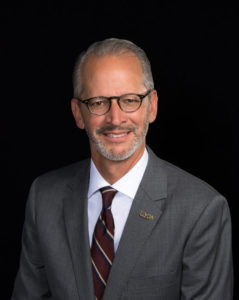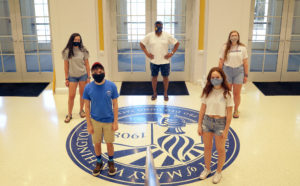Welcoming students back to campus is the right decision for Mary Washington. That’s what UMW President Troy Paino said in a video released late yesterday, in which he announced that, following a three-week delay of in-person classes, students will begin returning to campus on Sept. 10 and to limited in-person learning on Sept. 14.

“I will state the obvious,” Paino said in the nearly 19-minute video. “There is no consensus on how to proceed.”
He said he made the painstaking decision after conferring with medical experts, presidential colleagues, parents and others, always keeping the health and wellbeing of students, faculty, staff and area residents foremost in mind. He made the call, he said, for two primary reasons: his belief in the commitment of UMW students and University community members to make personal sacrifices for the greater good, and his confidence in a strong and adaptable plan thoroughly developed by faculty, staff and administrators throughout the past six months.
With an effective, widely available vaccine as far away as 18 months, Paino said, he was forced to weigh the risks of bringing students back to Mary Washington against those of going fully remote, foregoing the meaningful relationships and self-discovery that come with campus life.
“We cannot put this generation on hold for that long,” said Paino, the father of a college student and a recent college graduate. “They need to see that despite the challenges this virus presents, we can move forward with our lives.”
The early-August announcement to delay in-person classes gave UMW administrators time to gauge the course of COVID-19 and learn from issues faced by other colleges as they re-opened. Paino said he hopes the small size and academic focus of the Mary Washington student body, coupled with efforts aided by the City of Fredericksburg to discourage large off-campus parties, will help deter so-called “super-spreader” events.
The state and nation have experienced a slight but steady recent dip in diagnosed cases, Paino said in the video, and a UMW team has worked tirelessly to enhance the University’s capacity to conduct surveillance testing aimed at rapid detection of the virus’s presence on campus. He acknowledged, however, that certain factors – negative trends in public health data, lowered local health care bed capacity, supply chain constraints that undermine containment plans and a broad-based breakdown in adherence to social expectations – could necessitate a return to fully remote operations.

Referring to his April opinion piece in the Richmond Times-Dispatch, in which he reflected on his concerns about leading UMW through a pandemic, Paino said he hopes that collective sacrifice in the form of social distancing will help renew a sense of community and mutual respect. He said he’s counting on the type of commitment required of the returning campus community to underscore the public purpose of a liberal arts education, which holds service and community engagement among its core values.
In less than two weeks, when in-person instruction resumes at Mary Washington, 61 percent of classes will still be held completely online. Twenty-four percent, including many with a lab or studio component, will be delivered in a hybrid format that combines in-person and online learning. The remaining 15 percent will take place completely in-person, in classrooms that exceed CDC guidelines for social distancing, Paino said.
Residence halls have been reconfigured to reduce occupancy. Mandatory training and a widespread “MMDC Campaign” highlight the importance of monitoring, masking, distancing and cleaning. And an exhaustive array of precautionary measures, as spelled out in the #ForwardUMW plan for returning to campus, have been put into place.
“College, particularly at a school like Mary Washington, is about a lot more than sitting in a classroom for 15 hours a week,” Paino said, pointing to a young adult population with an increased rate of anxiety and uncertainty about the future. “You can still access a high-quality education online, but there are simply some components of a Mary Washington experience that occur on campus.”